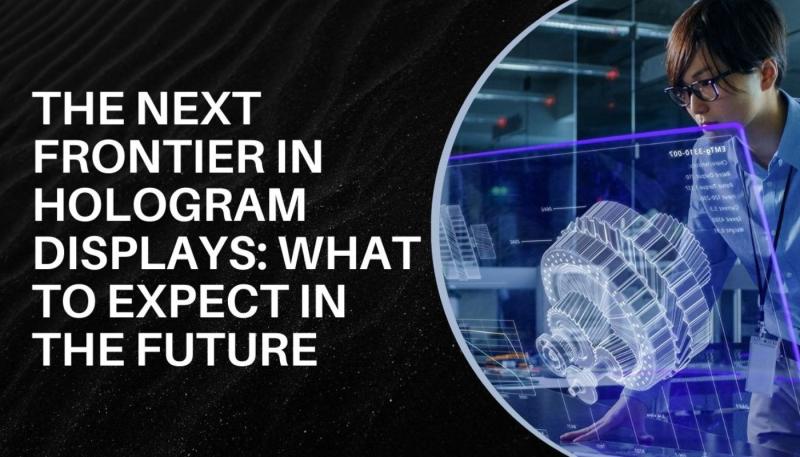The Next Frontier in Hologram Displays: What to Expect in the Future.

In this age, it is very instrumental that the involved promise of holographic displays in terms of the transformation of major sectors in communication, entertainment, health care, and education are highly regarded. In line with considering the next frontier of holographic displays, it becomes quite valuable to understand the current advancements, challenges, and future possibilities that this technology might offer.
Current State of Hologram Displays
Holographic displays are very important in their creation of three-dimensional images visible from different angles and are achieved by using optics, computer graphics, and data processing. The core technologies of such development are SLMs-Spatial Light Modulators-and Light Field Displays: SLMs manipulate light waves into holograms, while Light Field Displays capture and project all rays of light in a scene for a more realistic representation of objects.
However, many problems remain, which include the limitation of pixel size, cost, and lastly the complexities in generating and processing holograms through computers. Such setbacks prevent the development of large-format dynamic displays that are capable of updating at video frame rates. Furthermore, most of the conventional recording materials also can't bear the rapid CGH generation. Further research should be done to cross these hurdles.
Technological Innovations Driving the Future
Several key technological innovations are dictating the future of a holographic display. Among them, one vividly entails the following.
5G Technology
The integration of 5G technology has been a necessary attribute of the evolution of holographic displays. Featuring high-speed data transfer and low latency, 5G can support the real-time streaming of complex holographic data with a much better user experience. This is quite vital in those applications that require immediate interaction, like holographic telepresence and remote collaboration.
Artificial Intelligence and Machine Learning
Recently, both AI and ML have found more significant applications with holographic systems. Both these technologies can add much to the development of enhanced interactivity and responsiveness from holograms in the real-time analysis of user behaviors. For instance, AI algorithms may interpret user interactions and thus provide modifications in the displayed holography accordingly. On the other hand, ML may be used for enhancing image quality and depth perception for better immersion with intuitiveness.
Digital Twins
Digital twins are virtual replicas of physical things or systems. They also play a very important role in how a 3D Holographic Display works. By granting the ability to change the replicas in real time, digital twins enhance interactivity, finding a broad range of applications in corporate environments from product demos to data visualization.
Applications of Holographic Displays
Potential applications of Hologram 3D Displays will be very vast, thereby changing many fields.
Healthcare
Concerning healthcare, holographic displays will revolutionize medical training as well as patient care. For surgeons, seeing complex anatomy in three dimensions could enhance abilities in better planning surgeries or procedures and skillfully performing them. Also, holographic displays can allow distant consultations to be enabled and will make specialists more actively engage with patients.
Education
Holographic displays could even provide immersive learning experiences in educational settings. Students can learn from 3D models of historical artifacts, biological systems, or physical phenomena that enhance understanding and retention of complex concepts.
Entertainment and Gaming
The entertainment sector is set to benefit hugely from holography. With the introduction of holographic gaming, there is an assurance that unmatched levels of immersion and interaction involved within virtual worlds than what would have been possible with regular screens are realized. Holographic displays can also be included in concerts and live performances so that they are nothing less than spectacular.
Corporate Communication
Holographic displays can change the very interaction of presentations and meetings in corporate worlds. By offering a three-dimensional view of data or products, such displays indeed enable more engaging and informative interactions. Companies can show their feats and innovations in visually stunning formats, further improving communications with clients and stakeholders.
Challenges Ahead
Besides the bright future of 3D holographic displays, there are multiple problems to be resolved.
Standardization and Compatibility
As the technology of holography is developing, the aspect of standardization becomes very important. Whether different devices and platforms can work together will determine how far the holographic technology will spread. The players in the industry would have to work together to lay down guidelines and standards that enable interoperability.
User Comfort and Accessibility
Holographic experiences will need to become comfortable and accessible. The problems of user fatigue and discomfort with using such a device for extended periods must be solved. But making such holographic displays affordable and more accessible to users will be the key to the everyday application of holography.
Ethical Considerations
This opens a whole new dimension of opportunities with doors for ethical concerns about the representation of people, living or dead. This is a sensitive issue that needs to be handled with care by the industry to avoid misuse and ensure holographic technology is employed responsibly and ethically.
Conclusion
The frontiers for a holographic display surpass just a tussle with enhanced fidelity to the very redefinition of how humans interact with technology. As technology continues to evolve, holographic displays will someday be more intuitive, responsive, and commonplace. This opens up real possibilities for immersive, enriching experiences in everything from healthcare to entertainment and transforms the way we understand digital content. To learn more about holographic displays, connect with Vision3D customer care number - +91-8971953451.
Post Your Ad Here
Comments (1)
Jessica Louies6
Digital Marketer and Content Curator
Good information on this article very helpful